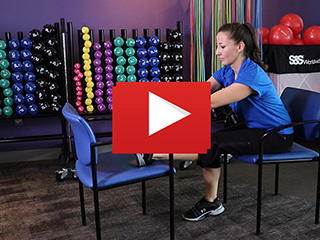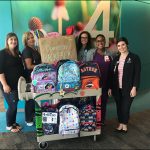It’s that time of year again! As many people are preparing to send their children back to school, we asked employees how they prepare their household for the new school year.
Walking the halls of Texas Children’s you may see someone in a red vest offering assistance or providing some type of support. Those are our volunteers, who have played an important role in the organization’s success since day one.
This summer The Woodlands Campus adopted the junior volunteer program to offer opportunities to teenagers and provide more support for patient care.
The volunteer program began when Texas Children’s opened its doors in 1954. Over the years the program has expanded to over 800 diverse active Auxiliary members who support patients, families and hospital staff.
“The role of the volunteer has really changed over the decades,” Assistant Vice President, Clinical Support and Research Administration, Paige Schulz said. “One of the things that’s really significantly changed is originally it was only women that volunteered at Texas Children’s. And then that was from the ‘50s really until the ‘80s, and then men started volunteering a lot more with our organization.”
Click below to view a video about the system-wide junior volunteer program.
In 2017, West Campus began their junior volunteer program based off of several requests from the Katy community. As the campus grew over the years, so did the need for a program.
“The juniors make a big difference in the patient’s experience in the hospital,” West Campus Senior Volunteer Coordinator Nora Lopez said. “When the patient comes in and they go to visit the doctor, they are scared. So if they play with someone before they are seen by the doctor, or nurse, or prior to any procedure or surgery, the patient is most likely in a better mood. So it’s a win, win situation and it makes a big difference in the hospital.”
The Woodlands Volunteer Services Department selected 12 high school students with an interest in working in the healthcare field to engage in tasks that enhances patient experience, whether it is providing games for them to play, snacks like popcorn and tea, or just having someone to talk to their age.
“The best part is their energy. They bring an enormous amount of energy to the hospital and their energy is contagious and it’s been so wonderful to have that contagious positive energy around the hospital,” The Woodlands Senior Volunteer Coordinator Zett Small said. “We are grateful to have the best, brightest, and most talented kids volunteering with us.”
Anvi Sana is a 16-year-old aspiring pediatrician who has always dreamed of working at Texas Children’s. The summer junior volunteer opportunity at The Woodlands combined her love for kids and thirst for the knowledge of health care. Sana expressed how much of a learning experience volunteering was and why it is beneficial for someone her age.
“I think as a teenager it teaches you a lot about the different kinds of people that you’re going to run into in a hospital,” Sana said. “I think doing a program like this as a teenager kind of opens up your eyes to the number of different people that you’re going to see or come across when you’re working in a hospital.
Being a volunteer at Texas Children’s is not just a job it is an experience for all ages, and backgrounds with endless possibilities.
“What I like to say about the volunteers are that they are the heart and soul of this organization,” Schulz said. “I’m excited about just the opportunity for us to expand beyond what maybe is a traditional volunteer assignment.”
Click here for information about the volunteer program.

You don’t have to be a victim of one of the latest mass shootings to be affected by them. Just hearing the news about the incidents in El Paso, Texas, and Dayton, Ohio, can cause anxiety, fear and a host of other emotions. And, for people sending children back to school this month, there’s an even heightened sense of sensitivity to such tragic events.
Failing to recognize these feelings and how to cope with them can begin to negatively affect your life and possibly hinder your daily performance as a Texas Children’s employee, parent, spouse or friend. Director of Texas Children’s Trauma and Grief Center and Texas Children’s Chief of Psychology Dr. Julie Kaplow assures employees they are not alone if they feel this way and recommends several tips on how to deal with the after-effects of a large-scale violent event.
Can mass shootings like the ones that recently occurred in El Paso, Texas, and Dayton, Ohio, affect people who are not directly impacted, and if so, how?
Whenever a mass shooting occurs, there’s often this sense of mortality, where you recognize that these things can and do happen. For many people, these events can change your world view a little bit. Generally speaking, we walk around feeling fairly secure in our environment, almost like there’s an invisible shield surrounding and protecting us, and then when something tragic or terrifying happens, it makes people feel more on edge, more hypervigilant, more worried or anxious.
How can people constructively deal with their feelings and emotions surrounding tragic events such as the recent mass shootings?
Social support is probably the No. 1 protective factor in the aftermath of any sort of disaster, including man-made disasters or acts of violence. Being around friends and family, people who can support you, is critical after something like this. We also need to be aware of the fact that for those who have a history of trauma, even if the traumatic event occurred many years ago, violent and distressing events like this can be triggering, meaning that oftentimes, even the physiological reaction you have to a mass shooting can remind you of the same physiological reaction you had to another event that happened years ago. Recognizing that these events often have a psychological impact, even if you weren’t directly involved, is key. Also, recognizing what safety precautions and measures are in place in your work environment or in your neighborhood can be comforting and can help to alleviate feelings of distress.
Should parents talk to their children about such events, and if so, what is the best way to go about doing so?
The most important thing, when talking to children about these events, is to let them guide the conversation. Oftentimes parents either err on the side of not sharing at all, or give a little too much detail and information. If developmentally appropriate, you can introduce the topic by saying something like, “You may have heard about something upsetting that happened in El Paso. Do you have any questions for me about that?” Then, let the child guide the rest of the conversation, revealing what they need to know as opposed to information that might be too overwhelming. Throughout the conversation, keep in mind that children mainly need to feel that they are safe and secure, and that the adults in their lives are going to take care of them. Caregivers can also remind them that even though bad things happen, there are lots of helpers out there who are looking out for them and protecting them.
Since opening in 2017, you and your team with the Texas Children’s Trauma and Grief (TAG) Center have launched two high-profile programs to provide ongoing support and healing to families impacted by Hurricane Harvey and the Sante Fe school shooting tragedy. Will your team be going to El Paso?
We have reached out to the El Paso community and the individuals who are on the ground providing assistance there to let them know we are ready and willing to help when and if we’re needed. Right now, the El Paso community is in the critical incident stress management stage, and our TAG team typically becomes involved a bit later in the process, focusing primarily on mental health needs assessment, training/consultation to community providers, intervention planning, and/or longer term recovery among families who have been impacted. So, we are really looking at being able to help two to three months down the road.
What can people do if they feel like their feelings surrounding such events are becoming too much to handle?
If someone is starting to feel like their anxiety is infringing on their ability to function in daily life, for example if they’re having trouble getting out of bed in the morning, going to work, or if they’re afraid to leave the house, then they should reach out to a trained, trauma-informed therapist for an evaluation and possible treatment. Some other red flags to look for are: constantly being on edge, having nightmares, trouble sleeping, trouble eating, engaging in risk-taking behaviors such as drinking excessively, or other forms of substance abuse. Someone exhibiting any of these feelings or behaviors would likely benefit from an evaluation.
Texas Children’s Employee Assistance Program (EAP) team has completed trauma and grief training with Kaplow, and is currently working with the Trauma and Grief team to develop a grief support group for Texas Children’s employees. EAP Manager Allison Bell said the team regularly provides counseling services to employees and eligible dependents with both concerns.
“Along with stress, grief is one of the top reasons that employees come to EAP,” Bell said. “Texas Children’s staff have tough jobs that have difficult and sad endings at times, and the EAP is there to support them. We provide EAP support to individuals, as well as entire units after critical incidents.”
EAP developed and manages Texas Children’s Tandem Support Team, which is designed to help employees cope with serious patient-related events such as errors, unanticipated outcomes or even patient deaths. Trained peer volunteers on the support team are available 24 hours a day, seven days a week, to offer guidance and reassurance to colleagues dealing with the profound emotions of stress, fatigue and blame that often occur after difficult events.
With EAP Plus, an enhanced program launched in January, employees and their families also have round-the-clock access to a certified counselor and confident emotional support services in their community for grief in the workplace, stress reduction and many more concerns.
For more information about EAP resources or to receive assistance with managing trauma and grief, contact the team at 832-824-3327. Additional details about EAP Plus, the Tandem Support Team and other services and programs – including a helpful brochure on how to cope after a traumatic incident and support fellow team members who have been affected – are available on the EAP page on Connect.
“The best way to deliver on Texas Children’s mission to provide exemplary care is to ensure our employees have the resources and support they need to build rewarding careers and lead healthy lives,” said Vice President Jermaine Monroe. “EAP is an important part of our focus on the total well-being of our workforce, and living compassionately as an organization that truly cares for our people and their families.”
Texas Children’s Health & Well-Being team has partnered with colleagues from Environmental Health & Safety, Physical Medicine and Rehabilitation and Occupational & Physical Therapy to launch this month the “We’ve Got Your Back” video series, which provides employees with expert advice and insight on preventing back pain in the workplace – no matter your location, shift or role.
We’ve Got Your Back Episode 3: Exercises to Help Prevent Back Pain
Now that you’ve learned about using ergonomics to set up a safe and comfortable work environment and practiced the proper body mechanics for lifting objects in the first two episodes of the series, check out Episode 3: Exercises to Help Prevent Back Pain for advice and guidance from Dr. David Hudspeth, an employee health physical therapist, board-certified orthopedic specialist and certified manual therapist in Texas Children’s Occupational & Physical Therapy department.
“Sometimes our day-to-day activities can result in lower back tightness and pain,” Hudspeth said. “Too much of a good thing – like sitting, standing or walking – can contribute to stresses on our body. One of the best ways to counteract these stresses is to perform a few simple exercises.”
Click here to begin the third episode of “We’ve Got Your Back” and explore how to prevent back pain by maintaining your flexibility and building core strength through the hamstring stretch, hip flexor stretch and plank. Once you’ve got those down, stay tuned! Hudspeth also explains how to progress in difficulty with each exercise to give your body even more of a challenge.
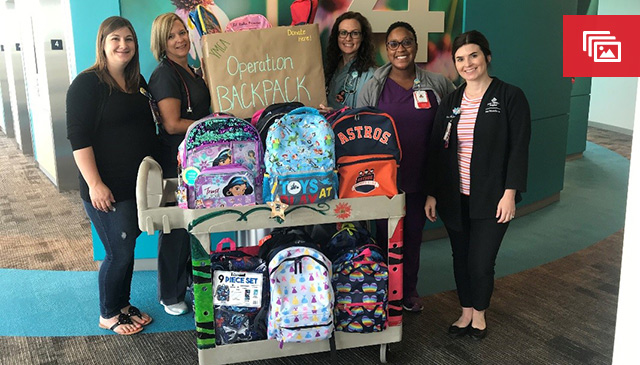
Back-to-school is a time full of anticipation as students get ready to learn new things and make new friends. However, it can also be a time of stress and anxiety for families who can’t afford back-to-school supplies.
To help ensure Houston-area students have the materials they need to start the year successfully, advanced practice providers (APPs) in the Department of Surgery APP Community Outreach Committee collected more than 50 backpacks filled with school supplies from across the three Texas Children’s Hospital campuses. The backpacks were donated at YMCA of Greater Houston locations and The Woodlands Family YMCA at Branch Crossing as part of YMCA Operation Backpack.
This was the fourth year APPs participated in the backpack drive, one of two major charitable initiatives held by the committee each year in which APPs from all Texas Children’s Hospital locations join forces for a common cause – to give back to the community. The other larger annual initiative is a food collection drive in January that benefits Houston Food Bank and Montgomery County Food Bank.
“Each campus participates in numerous events throughout the year, but we wanted to find a couple of opportunities to give back during the year when everyone can be involved,” said Jackie Broda, PA-C in Pediatric Urology and Clinical Lead of the Community Outreach Committee. “Going back to school is obviously a big thing for all our patients. So the backpack drive allows us to help kids get started back to school on the right foot.”
Supplies for each donation included:
- 1 new backpack
- 1 package of pens
- 1 package of #2 pencils
- 1 pencil sharpener
- 1 eraser
- 1 24-pack of crayons or 8-pack of markers or colored pencils
- 1 package ruled loose leaf 8.5 x 11 paper (wide ruled)
- 1 12” ruler
- 1 pair of child safety scissors
- 2 pocket folders
- 2 spiral notebooks (100 sheets each)
- 1 glue bottle or glue stick
- 1 composition notebook
The backpack drive and food drive are just a part of the busy annual calendar of charitable initiatives and community events that APPs take part in every year at each Texas Children’s Hospital campus. Committee members take an active role in organizing and also volunteer at these events, which include the annual Family Fun Runs, Camp For All 2 U, Teddy Bear Clinics and many, many more – and all in addition to the amazing care and support they provide for patients and families every day.
“It’s a source of pride that everyone comes together for these incredible causes, but it’s awe-inspiring how much everyone is willing to give back on top of all the amazing work they do helping our patients,” Broda said.
Department of Surgery APP Community Outreach Committee 2019 Backpack Drive
Clinical Lead: Jackie Guarino Broda, PA-C
Texas Children’s Hospital – Texas Medical Center campus
Lead: Marielle Faraone, PA-C
Co-project Leaders: Marielle Faraone, PA-C and Madison Fitzgerald, PA-C
Donated: 14 backpacks
Texas Children’s Hospital West Campus
Lead and Project Leader: Anna Shafer, PA-C
Donated: 12 backpacks
Texas Children’s Hospital The Woodlands
Lead: Stephanie McGee, PA-C
Co-project Leaders: Alaina Dozar, NP and Jill Goeltz, PA-C
Donated: 28 backpacks
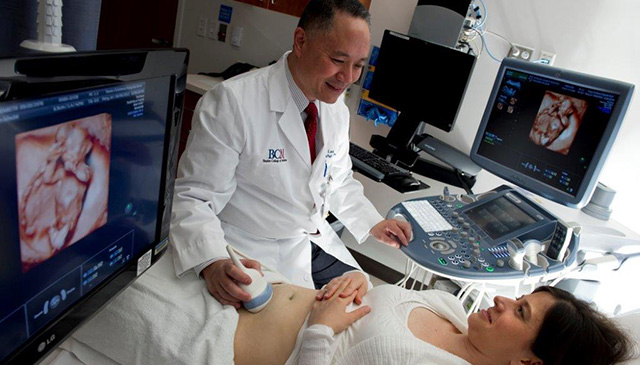
Fetal growth restriction is a major public health concern that can lead to short-term complications for the newborn and possibly the development of health problems later in life. Researchers at Texas Children’s Hospital and Baylor College of Medicine were recently awarded $3.2 million by the National Institutes of Health to develop an improved way to assess umbilical venous blood flow using 3D and Doppler ultrasound techniques. They aim to improve the detection and monitoring of small fetuses.
Fetal growth restriction increases the risk of stillbirth, problems during the newborn period, and neonatal death. Affected fetuses also are predisposed to developmental delay as well as the occurrence of adult diseases such as obesity, type 2 diabetes mellitus, coronary artery disease, and stroke.
“Our research team will initially validate the accuracy and reproducibility of new 3D volume flow measurements and then develop corresponding reference ranges in normal pregnancies,” said Dr. Wesley Lee, co-director of Texas Children’s Fetal Center and professor of obstetrics and gynecology at Baylor. “Detailed observations of fetal growth, heart function, and circulatory changes will be made in over 1,000 small fetuses with estimated weights below the tenth percentile. The results will be correlated with pregnancy outcomes to identify prenatal predictors of clinical problems in newborns.”
According to Lee, identifying the most vulnerable, small fetuses may not only influence their neonatal course, but could also have lasting impact on long-term health consequences during adult life. Researchers hope to develop 3D umbilical venous flow as a reproducible circulatory measurement that is accurate and clinically applicable, even during early pregnancy.
The five-year investigation is a collaboration between Texas Children’s Hospital, Baylor College of Medicine, University of Michigan, Perinatology Research Branch of the Eunice Kennedy Shriver National Institute of Child Health and Human Development and GE Healthcare.
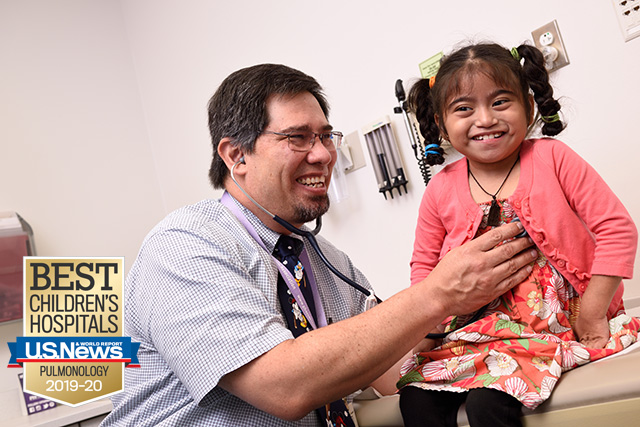
Texas Children’s Pulmonology recently celebrated a well-deserved milestone after learning they were ranked No. 1 by U.S. News & World Report for the second straight year in a row.
On June 19, the Pulmonology team gathered in a conference room on the 10th floor of Wallace Tower to celebrate this impressive accomplishment. Pulmonology, which first debuted in the top spot in the 2016 rankings, was once again recognized as the best in the nation for children in need of pulmonary care.
“At Texas Children’s, we built our program to serve the needs of children with all types of lung disease, from common ailments to the most complex cases,” said Chief of Pulmonary Medicine Dr. Peter Hiatt. “Our unrelenting commitment to providing life-changing and life-saving treatments to children is what motivates us every day to do better and ultimately achieve the best possible patient outcomes.”
The U.S. News rankings uses a methodology that weighs a combination of patient outcomes, quality of health care, available clinical resources, such as specialized clinics, external accreditations and compliance with best practices. Improved rankings show a healthcare organization’s commitment to providing high-quality care and identifying gaps where improvements are needed.
Big wins for patients and families
Building on the successes of previously existing programs, the Pulmonology team continues to make great strides in patient care and outcomes which were recently noted in the U.S. News rankings:
- Improved one year survival for lung transplant patients.
Texas Children’s has one of the largest and most successful pediatric lung transplant programs in the country. The one-year lung transplant survival metric is based on data collected from the United Network for Organ Sharing (UNOS) in the Scientific Registry of Transplant Recipients (SRTR) database. Based on this metric and when comparing the volume of our lung transplant patients across the country, the team has seen measurable improvements in our one-year lung transplant survival rate. - Improved growth percentile for cystic fibrosis patients 0 – 24 months of age.
Along with respiratory lung problems, cystic fibrosis patients may encounter digestive problems that can lead to nutritional concerns (malnutrition) and poor growth. Attention to nutritional status and lung function in the first years of life is crucial to promoting the most favorable outcomes. Our pulmonology team improved the median weight-for-length (WFL) growth percentile in CF patients (0-24 months of age) by focusing efforts on early intervention. This included working with our CF dietitians to manage nutrition and avoid calorie and nutrient deficiencies in this patient population. Also, the team collaborated with our CF Family Advocacy group to help under-insured or uninsured families obtain supplements. - Reduced hospital re-admissions for patients with asthma-related symptoms
Pulmonology develops the protocols that guide the organization on how asthma care is delivered to patients across the system. Multidisciplinary collaborations helped the organization decrease hospital re-admissions for exacerbated asthma-related symptoms. Our team collaborated with our partners at the Emergency Center and Texas Children’s Pediatric practices to manage care for chronic to high-risk asthma patients. Other efforts included educating patients about follow up care and the importance of asthma medication adherence to reduce unnecessary re-admissions. - Achieved below target threshold for hospital length of stay (LOS) for asthma patients
Texas Children’s stayed under the 2-day threshold for asthma length of stay on average. Prompt administration of systemic corticosteroid in the Emergency Department (ED) setting and having a focused unit for asthma inpatient care allowed for close monitoring and weaning of therapy to allow for a timely discharge. This was a partnership with the ED and hospitalist clinicians.
Click here to learn more about Texas Children’s Pulmonary Medicine and our services.


